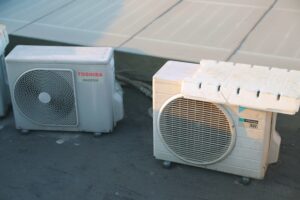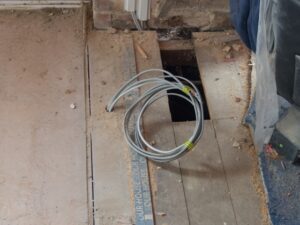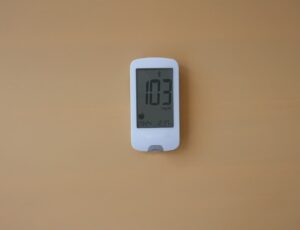Have you recently installed a new water heater, only to find yourself dealing with air in your hot water line?
It’s a common issue, but not one to panic over. While it might cause some noise or sputtering from your taps, it’s usually a quick fix.
But what causes air in the lines, and how can you get it sorted fast?
When a new water heater is installed, the pipes often get filled with air, especially if the system wasn’t fully flushed or bled during installation. As your system starts up, air can get trapped in the hot water line, leading to that irritating gurgling sound or uneven flow.
But don’t worry!
All you need to do is open your hot water taps and let the water run for a few minutes. This will usually expel the air, allowing the water to flow smoothly again.
But what if the issue isn’t resolved on its own?
Sometimes, the problem could be a sign of a more significant issue, like a pressure problem or an installation mistake. That’s where professionals like Excel Mechanical come in. We’re here to ensure your plumbing system works flawlessly, providing fast and affordable solutions tailored to your home or business needs.
In this blog, you will learn:
- Common causes of air in your hot water lines.
- Quick fixes you can try before calling a professional.
- How Excel Mechanical can assist with more complex issues.
Let’s get started!
Understanding Air in the Water Line
Air in the water line can cause problems like sputtering faucets and uneven water flow. Identifying the causes and recognizing the signs can help you address the issue effectively.
Causes of Air in Hot Water Lines
Air may enter hot water lines due to incorrect installation or recent plumbing work. The air might not have been fully purged if you’ve just installed a new water heater.
A faulty pressure tank or valve can sometimes allow air into the lines. A drop in pressure from your water source, such as during a repair, might also introduce air.
Regular maintenance by professionals can minimize these occurrences, ensuring your system is set up properly and functioning at its best.
Signs and Symptoms of Air in the System
When air is in your hot water lines, you might notice sputtering or a choppy flow when you turn on the tap. This is because air pockets disturb the water flow, causing inconsistent pressure.
You might also hear banging noises in the pipes or notice fluctuations in water temperature. If these symptoms persist, it’s crucial to have your system checked by experts.
Installation of the New Water Heater
Installing a new water heater involves careful planning and execution to ensure efficient performance and safety. Paying attention to proper practices and avoiding common mistakes can save you time and resources while extending the lifespan of your appliance.
Proper Water Heater Installation Practices
Follow key installation practices to ensure your water heater operates efficiently.
- Start by selecting the right size unit for your home’s needs. This involves estimating the peak hour demand for hot water in your household.
- Install the heater in a well-ventilated area with easy access for maintenance. This prevents overheating and ensures any leaks or issues can be quickly addressed.
- Align the unit correctly with the existing plumbing connections. Use flexible water and gas lines, allowing for easier adjustments and reducing the risk of connections failing.
- Check the vent pipe for proper alignment to ensure fumes escape safely. Seal all connections with Teflon tape or pipe joint compound to prevent leaks.
Professional installation ensures compliance with safety regulations and addresses individual needs.
Common Mistakes During Water Heater Replacement
Several mistakes can arise when replacing a water heater.
- One common issue is neglecting to flush the system before installing the new unit. This can leave old sediment in the lines, affecting water flow and heater efficiency.
- Improperly securing the heater can damage it. Make sure it is stable and braced correctly.
- Additionally, failing to follow local codes and regulations can lead to safety hazards and fines.
- Pressure relief valves are essential safety features; ensure they are installed properly.
- Another mistake is overlooking routine inspections post-installation, which helps identify issues early.
Diagnosing the Air Problem
Diagnosing air in your hot water line involves understanding possible causes and using the right tools for resolution. It’s essential to determine the source of the air and address it effectively to ensure the smooth operation of your new water heater.
Initial Assessment and Troubleshooting
- Start by checking if the air issue begins shortly after installing your new water heater. If so, it’s likely related to installation.
- Listen for unusual noises when you turn on the hot water taps. Bubbles often indicate trapped air.
- Inspect connections and ensure all fittings are tight. Check for leaks that might have allowed air into the system. If your water sputters, it could suggest trapped air bubbles or blockages in the line.
- Bleed the air by opening all water fixtures until a steady stream flows to help release the trapped air. If the problem persists, you may need professional help.
Tools and Equipment for Diagnosis
You’ll need basic tools such as adjustable wrenches and pliers to check connections.
A water pressure gauge helps assess the pressure and ensure it’s within the recommended range. Using an air release valve can help effectively vent trapped air. Keep pliers and hose clamps handy for adjustments.
When troubleshooting issues with your new water heater, consider professional expertise. Excel Mechanical excels in providing high-quality HVAC and plumbing services. Our commitment to personalized solutions ensures your system functions according to your needs and budget, maintaining exceptional standards and value.
Resolving the Issue
If you’re facing air in your hot water line after installing a new water heater, several steps can help solve this problem. Common approaches involve releasing trapped air, managing water pressure, and assessing the expansion tank.
Bleeding Air from the Lines
Letting out trapped air from your home’s water lines is essential to smooth water flow.
Start by turning off the water heater. Then, open the hot water faucets in your home, starting with the furthest one from the heater. Keep the faucets open until the water flow is steady and all air is released.
Using a simple checklist can be handy:
- Turn off the water heater.
- Open all hot water faucets.
- Wait until the water flows steadily.
Performing this process occasionally ensures your water lines are clear of air.
Checking and Adjusting Water Pressure
Incorrect water pressure can cause air issues.
Use a gauge to measure the pressure at your home’s entry point. The ideal pressure usually ranges between 40 to 60 psi. If the pressure is too high, adjust it using the regulator valve, typically found near your main shut-off valve.
Steps to adjust pressure include:
- Attach a pressure gauge.
- Check the pressure reading.
- Adjust the regulator valve if needed.
If adjustments don’t fix the problem, contacting experts can save time and effort.
Inspecting the Expansion Tank
The expansion tank manages pressure changes in the system.
Inspect it for signs of wear or damage and make sure it’s correctly sized and functioning. An improperly working expansion tank may not handle pressure changes, allowing air into your water lines.
To inspect your tank:
- Check for leaks or rust.
- Ensure the pressure is maintained.
- Confirm the tank size is suitable.
Preventive Measures and Best Practices
Maintaining your water heater can prevent problems like air in the hot water lines. Regular upkeep and using quality parts are essential for long-lasting performance and efficiency.
Regular Maintenance Schedule
Establish a regular maintenance schedule to keep your water heater functioning optimally. You should check the system at least once a year. Check for leaks and sediment buildup and ensure the pressure relief valve works correctly.
Flushing the tank to remove sediment is crucial as it prevents blockages and overheating, extending the heater’s lifespan. Additionally, if your water heater has an anode rod, ensure it is not overly corroded, as it protects the tank from rust.
Listen for unusual noises during maintenance and monitor consistent hot water supply to catch issues early.
Upgrades and Quality Parts for Longevity
Using high-quality parts and considering upgrades can significantly enhance the lifespan of your water heater. Invest in durable materials for parts like pipes and valves, which are less prone to wear and failure. When necessary, upgrading to advanced filters and an efficient anode rod offers better corrosion resistance.
Professional Assistance
When you encounter air in your hot water line after installing a new water heater, it might be time to consider seeking professional help. While DIY solutions can work, professional assistance ensures the job is done efficiently and safely.
Symptoms:
- Bubbling or Sputtering Sounds: This can indicate trapped air.
- Fluctuating Water Temperature: Inconsistent water heat may result from air in the lines.
Hiring a professional can prevent potential complications. They possess the expertise to identify and fix the issue effectively, ensuring your hot water system functions smoothly.
Benefits of Hiring Professionals:
- Expertise and Experience: A professional has the skills to tackle these problems quickly.
- Safety Assurance: They guarantee that your water heating system complies with safety standards.
Consider Excel Mechanical:
At Excel Mechanical, you’ll find trained professionals who strive for exceptional quality. We take the time to understand your needs and offer solutions that fit your budget. Our team specializes in both residential and commercial HVAC and plumbing services, making us an excellent choice for your needs.
Investing in professional assistance gives you peace of mind and can extend your water heater’s lifespan.
Frequently Asked Questions
After installing a new water heater, it’s common to encounter air in the hot water lines. This can cause sputtering faucets and is a clear sign that air needs to be purged from the system. Here are some frequent queries about addressing this issue.
How can one fix air pockets in hot water lines after installing a new water heater?
Air pockets in your hot water lines can be frustrating. You can start by running your hot water faucets to help push the air out. Ensure the taps furthest from the water heater are opened first to allow the system to balance.
What are the steps to remove air from hot water pipes effectively?
To effectively remove air from hot water pipes, open all faucets from the lowest to the highest point in your home. This allows air to escape. You may also need to check for leaks that allow air into the system.
What could be the reasons for air presence in hot water lines?
Air can enter your hot water lines after system installation, during maintenance, or due to leaks. When water is drained, or air is introduced to the system, it can cause bubbles and noise in the pipes.
After draining the system, why might air be in the hot water lines, and how can it be resolved?
Draining the system might not remove all trapped air. Running all hot water taps can help clear the lines. If the problem persists, professional help from a provider like Excel Mechanical may be needed to ensure no underlying issue.
How much time is typically required to eliminate air from water lines after replacing a water heater?
The time it takes to remove air varies. It can range from a few minutes to an hour, depending on the plumbing layout and the severity of the air issues. Patience and careful attention are essential during this process.
What is the proper method to purge air from a newly installed water heater?
To purge air, fully fill the water heater, then open all hot faucets. Let the water run steadily for a few minutes until the sputtering stops.




